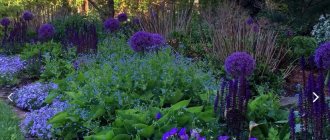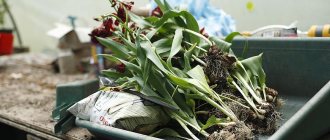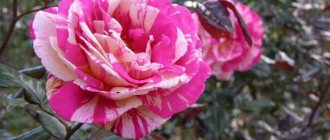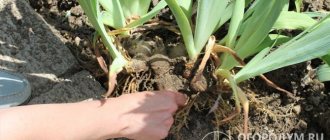These magnificently beautiful flowers, similar to orchids (but not at all) can be found in all corners of the Northern Hemisphere - from 30⁰ northern latitude and up to the 70th parallel, where the polar zone with its permafrost soil begins. In the wild, you can often find a fellow iris (or iris, or cockerel) - with a bright blue or blue-violet color. In which the “beard” of the lower petal is colored with yellow thin longitudinal stripes running deep into the throat, like a guide path for pollinating bumblebees. But the hero of our material is no less common. True, it has a difference from other varieties and subspecies - it lives “knee-deep” in water, while other irises try to climb higher, onto the slopes of hills, hills, and sometimes just hillocks.
Description of marsh iris
Swamp iris, depending on the description and photo, is a herbaceous perennial growing in fresh water bodies. The strong rhizome develops well in such an environment and accumulates nutrients in it.
Growth points are located in the lateral part of the root of the marsh iris, which makes it possible for the shoots to bend horizontally in different directions. Thanks to this, voluminous bushes are obtained.
Attention! The place of formation of leaves and flowers in the marsh iris is the buds located on the rhizome.
The xiphoid wide plates are light green or variegated. With proper care and the creation of appropriate conditions, they grow up to 2 m in length.
The marsh iris has up to 15 powerful branched peduncles. Each bud has three petals in the outer circle and the same number in the inner circle. The color may vary depending on the variety and classification of marsh iris. The palette of buds is:
- yellow (with an orange core);
- blue;
- purple;
- white.
Varietal plants have an external resemblance to wild iris, so it has other names - calamus (irris).
The plants bloom in June, and by mid-July the marsh iris has formed a seed pod
In nature, the fruit cracks, black grains spill into the water, where they then germinate. They do not sink for a long time and float on the surface. This is because they have an air cavity.
Iris calamus is not only a beautiful plant that has long attracted the attention of landscape designers. The flower is a medicinal species. The rhizomes of swamp iris are used for coughs, migraines, sore throats, and gastritis. Iris leaves are rich in vitamin C and amino acids.
Why is the false calamus iris listed in the Red Book?
False calamus iris grows up to 1.5 m. It is distinguished by flat, long leaves of green or bluish color.
The upper petals of the yellow buds are slightly underdeveloped, they are shorter than the outer ones. Among the calamus irises there are representatives with white flowers.
The rhizome is powerful, dissected, which ensures successful growth of iris. Unfortunately, due to drought or forced drainage of swampy areas, the number of plants is reduced. All yellow marsh irises, regardless of variety and description, are listed in the Red Book.
Growing in summer cottages, in parks, near artificial reservoirs helps protect the crop from extinction
Special properties of the plant
Iris calamus has many beneficial properties.
- It contains essential oil that has the scent of violets. Iris oil contains more than 140 useful components: benzoic acid, esters, aldehydes, phenol, furfural, ketone.
- Rhizomes contain starch, fatty acids, oils, and resins. The leaves are rich in ascorbic acid and amino acids.
- Rhizomes are used to treat diseases of the respiratory, digestive and urinary systems.
- The flavonoids it contains prevent the development of blood vessel diseases, normalize blood pressure and heart function.
- The flower has antimicrobial, antispasmodic, tanning properties.
- In folk medicine, decoctions of the rhizome are used as an expectorant. They treat migraines, sore throats, bronchitis, and diseases of the gastrointestinal tract.
Swamp iris in landscape design
Swamp iris with yellow and blue petals has long been particularly popular among landscape designers. This is no coincidence. The plant is easy to care for and grows quickly. Thanks to it you can create various flower arrangements.
Application options:
- yellow marsh iris looks great in areas next to trees and shrubs;
Bastard flowers reach 12-14 cm in diameter - next to other perennials;
- as tapeworm groups on lawns;
- single landings;
Dense bushes with long peduncles can decorate any area - flower beds with colorful marsh irises look great;
- On ponds, small lakes or wet beds, varieties of yellow swamp iris are placed in rows or clumps.
You can plant various aquatic plants next to the marsh iris.
Attention! If there is a wetland at the dacha, then it is quite suitable for growing such a crop of any variety.
Siberian
It is rare to find Siberian iris in the garden; it is more often found in natural meadows. The Siberian species prefers sunny positions. It forms large bales and is not particularly picky about the soil. Siberian iris can grow up to 70 cm in height. The leaves stand out in appearance; they are quite long, thin, and acquire a slightly blue tint.
The plant produces small white or purple flowers, developing in groups of 2-3 at the end of a long, thin shoot. These are not the only colors, there are also blue irises. Flowering period: May – July.
The Siberian species is frost-resistant, so it grows well in our climate. However, this requires fertile soil with a slightly acidic reaction. Its cultivation is not difficult, there are no big requirements. Since the Siberian species loves moisture, regular watering is most important, especially during drought. Fertilizer is carried out only before planting if the soil in the garden is not fertile enough. The plant can overwinter in the ground without freezing. Despite this, it is worth covering it with leaves or straw.
The most popular varieties of violet-blue flowers. However, in addition to this, other colors are also available. The White Siberian Iris is distinguished by its beautiful white flowers. White Siberian irises are believed to be a variety originating from Germany, although this is not official. Grows well in sunny places, on fertile soil. The variety is considered the most noble.
| Name of iris | Photo |
| Snow Queen | |
| Barbata Media is a plant 40 cm high. | |
| Barbata Elatior - flowers 70 cm high. | |
| Siberian varieties are blue-blue in color - flowers bloom from July to August. Flower petals are smaller, but with more inflorescences. One of the most interesting varieties is Perrys Blue. This variety blooms very profusely with blue spring flowers (blooming: May-June). The plant is completely frost-resistant. It can be planted in flower beds. Looks great next to a pond. |
Cultivars are usually intensely colored, may have white or yellow patterns, and larger inflorescences.
Some varieties of the Siberian species - photos and descriptions
| Variety name | Siberian Iris – photo |
| Concord Crush - flower petals turn blue, turning into a purple hue. The variety is called multi-petalled. Flowering begins in May. | |
| Dear Delight is a flower with blue petals with white spots and a visible vein structure. | |
| Hubbard - varieties characterized by an intense purple-pink color. The flowers are very large, with white coatings along the edges of the petals. | |
| Jamaican Velvet is a variety of intense purple color. The petals are distinguished by lighter spots, which are characteristic of this flower. | |
| Pink Parfait “Pink Parfait” is a multi-petaled variety, the flowers of which reach a diameter of 16 cm. The color of the flowers is pink. | |
| Miss Aplle is a hardy flowering plant that is distinguished by its relatively young age compared to other varieties. The color of the pink petals turns into lavender and purple. | |
| Rosy Bows is a variety with double petals. The pink color turns into light purple, blue. | |
| Jeweled Crown | |
| Fortel | |
| Contrast in Styles |
Features of reproduction
Like other plants, swamp iris reproduces in a variety of ways. Each of them is good in its own way:
- By dividing the rhizome. To do this, you need to dig up a swamp iris bush with a good lump of soil and clean the root. Using a sharp knife, cut into slices. Each of them should have 2-3 lateral buds and one central shoot. Sprinkle cut areas with charcoal or ash to prevent disease. Cut off the leaves a little before planting. To root, plant the cuttings first in containers and then in a permanent place.
- Seed propagation. The material has a dense peel, so it requires stratification for germination. Swamp iris seeds are sown in the ground late in the fall and a film is placed on top. In spring they are planted.
Comment! Swamp iris grown from seeds will bloom only after three years, so flower growers most often prefer the vegetative method.
Varieties with a rich history
The most numerous are high varieties bred in different periods of the last century. In addition, several of the most ancient varieties, bred in the 19th century, stand out.
| Name | Photos |
| "Flavescens" (De Candolle, 1813) | |
| "Honorabile" (Lémon, 1840) | |
| "M-me Chereau" (Lémon, 1844) | |
| "Mrs Horace Darwin" (Foster, 1888) |
The group of low (miniature, dwarf) and early flowering represents about 20 varieties, including:
| Name | Photo |
| Buddha Song | |
| Derring-Do | |
| Forest Light | |
| Lilli-White | |
| Scribe |
It is difficult to name the most beautiful varieties of irises. However, it is worth mentioning some of them, which have received many awards, including the highest award - the British Dykes Medal from the British Iris Society.
| Name | Photo |
| Amethyst Flame with amethyst pink flowers | |
| Eleanor's Pride with blue | |
| Stepping Out background with white and purple | |
| Sable Night with black veins |
Planting swamp iris
Swamp iris should be planted in a permanent place in August-September. The area must be protected from drafts. The planted cuttings will bloom next summer.
When choosing swamp iris seedlings, you should pay attention to their appearance. Roots and stems should be free of damage, signs of rot, traces of diseases and pests.
Irises are planted in a damp place or shallow water, in areas open to the sun. The acidity of the soil should be 7 pH, fertile, with a high clay content.
Planting stages:
- To control the growth of seedlings, seed is placed in large containers with fertile soil.
- The soil is well moistened until it becomes mushy.
- The rhizomes of the iris are cut by 1/3, and the leaf blades are also shortened.
After preparation for planting, plants will spend energy on rooting - The seedling is placed to a depth of 10 cm. In this case, the root is not placed in the center of the container, but closer to the walls.
- The thickening on which the growth points are located is left above the ground.
- Then containers with marsh iris seedlings are placed in a permanent place in the reservoir and immersed to 20-40 cm.
You can plant the crop directly in open ground
Advice! In seedling containers, seedlings are placed in flower beds.
Reticulate
Iris reticulata is the main representative of the bulbous iris species. It usually reaches a small size (about 15-20 cm), and is one of the first to bloom in spring (III-IV). After flowering in early summer (VII), it dries out and the plant can begin to propagate. The flowers usually have varying shades of purple, with contrasting yellow spots on the petals, although some are also quite yellow. Blue irises are common.
The reticulated iris should grow in sunny places, protected from the wind. The best soil for it is permeable and warm. The species is ideal for rock gardens, edgings, and creating an early spring garden in a container. The soil should warm up quickly. The bulbs are planted at a depth of 5 to 6 cm.
Most popular varieties
| Name | Photos |
| Ash Gem | |
| Cantab – light blue | |
| Harmony – deep blue sky colors | |
| Ida – blue with dark blue and yellow spots | |
| Joyce – sky blue | |
| Katharine Hodgkin – pale blue and yellow | |
| Natascha – light blue with white and golden yellow spots | |
| Pauline – purple with white spots | |
| Ash Gem or Violet Gem – purple and plum purple |
Features of care
Gardeners do not encounter any particular difficulties when growing plants. Swamp iris is unpretentious. You just need to fulfill some conditions at the time of landing:
- Lighting. The leaves and flowers of the crop are not afraid of the open sun. Moreover, plants should be illuminated all day.
- Watering. If irises are planted in ponds or in a swamp bed, then additional irrigation will not be required. In other cases, the soil is constantly kept moist, preventing the top layer from drying out. In hot weather and drought you will have to water twice a day.
- Feeding. Plants planted in ponds do not need fertilizer. In other cases, you can add a complex composition after flowering, for example, “Kemira”.
Should swamp iris be pruned for the winter?
When growing swamp iris, gardeners do not experience any particular difficulties. The only point that you should pay attention to concerns the trimming of the ground part. This procedure is mandatory and is performed several times during the growing season.
In what cases is pruning carried out:
- If spots appear on the leaf plates or they have lost their decorative properties due to pests.
- After flowering is over, so that nutrients have time to accumulate in the rhizomes.
- At the end of autumn before frost.
- In accordance with the rules of agricultural technology of individual varieties.
During pruning, leave a third of the height of the leaf blades of the marsh iris.
Pests and diseases
Despite the fact that plants are unpretentious, unfortunately, it is not always possible to maintain their health. From time to time the crop gets sick and is affected by pests.
What can swamp irises suffer from:
- Alternaria blight. Unfortunately, plants cannot be cured; you only need to destroy and disinfect the soil.
- Ascochyta blight causes the leaves to dry out. For treatment, preparations containing copper are used.
- The cause of heterosporiosis can be prolonged rains and warm summers. The disease damages flowers. There is no cure; you need to pick off the affected petals in a timely manner.
- To treat rot on swamp irises, solutions containing sulfur are used.
Advice! Fighting diseases is difficult; it is better to prevent them. In spring and autumn, it is recommended to treat plants and soil with Bordeaux mixture.
If we talk about pests, irises can suffer from:
- Khrushchev;
- wireworm;
- onion fly;
- gladiolus thrips;
- nematodes
It is useful to treat plantings with special solutions. The drugs are diluted in accordance with the recommendations in the instructions.











